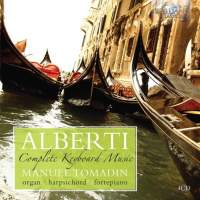Texte paru dans: / Appeared in: |
|
| Highly recommended |
Outil de traduction ~ (Très approximatif) |
|
Reviewer: Bertil
van Boer If there are two composers whose short lifespans are lamented during the 18th century, surely among the shortest were Giovanni Pergolesi and Domenico Alberti. The former died at the age of 26 from tuberculosis after achieving meteoric fame, and throughout the remainder of the century his music was considered as the epitome of early galant style. Indeed, his fame spread throughout Europe, enough so that a number of works were attributed to him on reputation alone, even though he didn’t actually write them (and I am principally reminded of Wassenaer’s concerti grossi). Alberti, on the other hand, almost completely vanished into obscurity, even though he was possibly the originator of the split arpeggiated bass line known even today as the Alberti bass and used by practically every Classical-period composer on into the next century. So, who was this fellow? The answer is most interesting. He was born in 1710 to a noble family in Venice, studying while still a child under Antonio Lotti. The chorus master at St. Marks also taught him singing with enough proficiency that even later in life the great Farinelli remarked on his talent. A professional career in music was not, however, in the cards, and at about the age of 18 he was appointed as a page to the Venetian ambassador to Madrid, where he spent the next several years. In 1737, however, he went to Rome, this time being employed as a singer for the Molinari family, and it is here that he attained a remarkable reputation, both for his voice and for his music. That year he composed at least two operas, followed by two or three others, as well as a huge number of insertion arias, sacred music, and instrumental keyboard works. He also apparently loved to wander the streets of Rome as a minstrel, attracting Pied Piper style flocks of groupies. Unfortunately, he too succumbed to tuberculosis at the age of 30. Unlike his colleague Scarlatti, Alberti chose a two-movement format, usually both in about the same tempo. This allowed for contrast thematically (and occasionally rhythmically and harmonically), but kept things as a musical bundle. There are no extremes here. Even those labelled “toccata” are really sonatas. As to the instruments, Alberti was not picky, calling almost all of them keyboard. Even the eight sonatas published in England in 1748 are generic, even though the titlepage specifically mentions the harpsichord; that is, they are indistinguishable from any of his other works. The number of works on this set are, of course, too many to discuss individually, but keyboardist Manuel Tomadin has chosen to alternate between different instruments. The first disc is done on the organ. Here, as an example, the first “Toccata” in B♭Major begins with a buoyant and effervescent Allegro, with introductory chords followed by a nice lyrical line (all above the usual bass). There is some nice thematic development, although much of the modulations are done via sequences. The writing is quite virtuoso at times, with some impressively rapid finger-work. The following Presto (actually only able to be done about Allegro) consists of a double antecedent followed by a double consequent theme. Each section ends with rising broken arpeggios on a tonic triad. While there are hints of the Baroque in some of the sequence patterns, the entire result is quite Classical in tone. The second disc is performed on the fortepiano. There is a sort of old-fashioned toccata (in F Major) that seems a throwback to an earlier era, and there is a single-movement sonata (in G Major) that might be an imitation of Scarlatti. However, the latter is quite Classical (one might almost say Mozartean). The lyrical theme floats along, but there are sudden twists in a minor key. The melody then wanders in a sort of perpetual motion manner until the concluding cadences. Scarlatti’s works seem almost stylistically hesitant in comparison. A final example I would put forward is the third sonata from his op. 1 in C Major. Here, we are in a simpler world, with a long lyrical line, tastefully ornamented, above the usual bass. Modulations are accommodated simply and easily through the alteration of notes in the Alberti bass, making them smooth and eloquent. There is a sudden turn to the minor in the second section of this rounded binary form, with a sequential rise that reminds one of C. P. E. Bach (though before his time), and yet the flow is never interrupted. The second movement is an easy and accessible minuet, something that a young Mozart might have heard and imitated in his earliest keyboard compositions. Tomadin performs with equal grace on all three instruments, demonstrating the interchangeability of the music. The phrasing is precise and convincing, and Tomadin has a positive knack for making the simplest of lines and lyrical themes interesting and listenable. He will have done a tremendous service to the world of music in this recording, for it demonstrates that Alberti, considered equivalent to a stereotype, conformed to his alleged pied piper status by providing a solid and serviceable compositional technique that led composers all the way into the 19th century. Moreover, the pieces are not commonplace, but rather show the talent the composer had for taking lyrical lines and projecting them without complications. In short, move over Scarlatti, for there is another rival in town. Highly recommended.
| |
|
|
|
|
Cliquez l'un ou l'autre
bouton pour découvrir bien d'autres critiques de CD |
|




